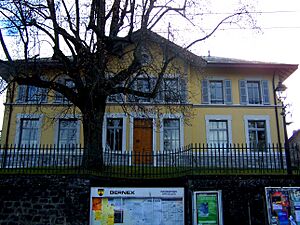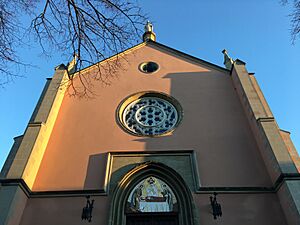Bernex, Switzerland facts for kids
Quick facts for kids
Bernex
|
||
|---|---|---|

Catholic Church of Bernex
|
||
|
||
| Country | Switzerland | |
| Canton | Geneva | |
| District | n.a. | |
| Area | ||
| • Total | 12.95 km2 (5.00 sq mi) | |
| Elevation | 380 m (1,250 ft) | |
| Population
(Dec 2020 )
|
||
| • Total | 10,258 | |
| • Density | 792.1/km2 (2,051.6/sq mi) | |
| Demonym(s) | Bernésien / Bernésienne | |
| Postal code |
1233
|
|
| Localities | Bernex, Lully, Sézenove, Loëx, Chèvres, Cressy, Challoux | |
| Surrounded by | Aire-la-Ville, Cartigny, Confignon, Laconnex, Onex, Perly-Certoux, Satigny, Soral, Vernier | |
Bernex is a town, also called a municipality, located in the Canton of Geneva, Switzerland. It's a lovely place with a rich history and beautiful natural surroundings.
Contents
History of Bernex
Bernex was first mentioned way back in 1256. It was known as Brenay then. Later, in 1793, Bernex joined with two other places, Onex and Confignon, to form one big municipality called Bernex-Onex-Confignon. But this didn't last forever! In 1850, Bernex decided to become its own separate municipality again.
Geography of Bernex
Bernex covers an area of about 12.95 square kilometers (5 square miles). A big part of this land, about 59%, is used for farming. Forests cover about 16.5% of the area, making it a green place. About 21.3% of the land is built up with buildings and roads. Rivers and lakes make up about 3.2% of the area.
The town is located on the left side of the Rhone river. Bernex is made up of seven main villages and several smaller hamlets. These hamlets include Chèvres, Loëx, Lully, Cressy, Challoux, and Sézenove. The seven villages are even shown on Bernex's coat of arms as seven flames of fire on a hill!
This hill is called the Signal de Bernex. It's the highest point in the municipality, reaching 506 meters (1,660 feet) high. It's also the second highest point in the whole Geneva canton.
Nearby Towns
Bernex is surrounded by several other municipalities. These include Satigny to the north, Vernier to the northeast, and Confignon to the east. To the south, you'll find Soral, and to the west is Cartigny.
People of Bernex
Bernex has a population of about 9,747 people as of 2022. Over the past ten years, the number of people living here has grown by about 11.2%. Many people from other countries also live in Bernex, making it a diverse community.
Most people in Bernex speak French, which is the main language. Some people also speak German or English.
In 2008, about 49.2% of the population were boys and men, and 50.8% were girls and women. Many people living in Bernex were also born there.
The chart below shows how the population of Bernex has changed over time:

Economy and Jobs
In Bernex, many people have jobs in different areas.
- The primary sector involves jobs like farming and forestry. About 170 people work in this area.
- The secondary sector includes jobs in manufacturing and construction. Around 425 people work here.
- The tertiary sector is the largest, with about 1,533 people working in services. This includes jobs in sales, transportation, hotels, healthcare, and education.
Many people who live in Bernex travel to other towns for work. Also, some people come from outside Switzerland to work in Bernex. Most people get to work by car, but some also use public transportation.
Religion
In Bernex, many people are Roman Catholic, making up about 40.5% of the population. Another large group, about 21.3%, belongs to the Swiss Reformed Church. There are also smaller groups of people who follow other Christian faiths, Islam, Judaism, Buddhism, and Hinduism. Some people don't belong to any church.
Education in Bernex
Education is important in Bernex. Many adults have finished high school, and a good number have gone on to college or university.
The school system in Geneva, where Bernex is located, offers two years of optional Kindergarten for young children. After that, students attend six years of primary school. Then comes secondary school, which has three required years, followed by three to five years of optional advanced schooling.
During the 2009-2010 school year, there were over 2,100 students in the Bernex school system. This included children in pre-kindergarten, primary school, and secondary school. Some students also attended private schools.
Important Buildings and Monuments
One of the most important buildings in Bernex is the Roman Catholic Church, dedicated to Saint Maurice. It was built a long time ago, between 1864 and 1865. This church is famous for its beautiful neo-gothic style and amazing stained glass windows. These windows were made by a talented artist named Abbot F. Pron. The church has been restored several times and is now a protected part of Switzerland's heritage.
Caring for the Environment
Bernex is also known for its efforts to protect the environment. Since 1988, the town has had a special program for recycling organic waste, like food scraps, for composting. This was a very new idea in Switzerland at the time! In 2017, Bernex also announced a plan to greatly reduce its use of fuel oil by the year 2030, showing its commitment to a greener future.
See also
 In Spanish: Bernex (Ginebra) para niños
In Spanish: Bernex (Ginebra) para niños







